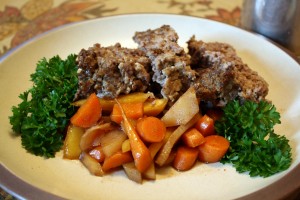At the Minnesota Renaissance Festival, I perform various cooking demonstrations with my assistants. In past years, we’ve created a lot of food that needed to fill empty bellies, but we didn’t have the means to do so. A couple of years ago, we developed a way of performing the cooking demonstrations and feeding the cast. Last year, we dubbed the concept as The Family Table.
There, cast members could get some hand crafted meals, water, and a place for the community to connect. We prepared a meat and vegan dish each day. On a couple of the list serves, that I belong to, I posted some facts about the family kitchen.
- Each day of the 2010 run of the Minnesota Renaissance Festival, The Family Table served between 85-125 people.
- On Saturday, October 2, 2010, we broke a record by serving 122 cast members in 40 minutes (shortest time for service). We believe it was due to the cold weather. On Sunday, October 3, 2010, we prepared for the day and fed 185 cast members.
- MRF provides a stipend for a food budget, but following it would allow us to feed the cast through 5th weekend. The cast’s tips and donations help us stretch the budget to feed the cast throughout the entire season.
- Each week, Cub, Rainbow, Kowalski’s, Lunds, Sam’s Club, and Costco are all shopped to get the best prices
- Every bowl is washed and bleached so that they remain food safe. At the end of the run, every bowl, cast iron pot, and wooden utensil is oiled and prepped for storage over the winter.
- All of the equipment for The Family Kitchen weighs 1750 lbs and includes two tables, tent, fly, cast iron pots, travel stove, shelving, period kitchen, shelving, coolers, etc.
- I kept a running tally through the season. We went through a lot of food (roughly):
Black Beans 14 lbs
Chickpeas 22 lbs
Lentils 8 lbs
Zucchini 100 lbs
Rice 100 lbs
Bread 65 lbs
pumpkins 23 lbs
leeks 30 lbs
onions 15 lbs
potatoes 117 lbs
carrots 130 lbs
chicken 140 lbs
beef 150 lbs
pork 72 lbs
meatballs 27 lbs
kielbasa 30 lbs
turkey 60 lbs
mushrooms 16 lbsI hope that The Family Table can become a not-for-profit entity for next year. I am looking for a lawyer who specializes in filing for not-for-profit status in Minnesota and is willing to work pro-bono. If you have any referrals, please let me know.

